Executive Summary
The motivation of the employees in the workplace is considered to be one of the manager’s primary duties. This is especially true in sectors dedicated to working with people, such as the hospitality sector. Hotel service is considered to be one of the most socially-intensive jobs, and at the same time, it sees increased levels of burnout and turnover among its employees. This research is based on personal experience from working in a motel located in Auckland, New Zealand. It is a quantitative study that takes the form of a survey, followed by an analysis and a recommendation section based on the survey findings.
The survey conducted among the employees of the motel indicates that they see the manager as the primary catalyst in workplace motivation. Other findings indicate that personal respect and acknowledgment of one’s efforts, as well as a well-defined and accessible system of bonuses and rewards, play a key role in improving the employees’ workplace motivation.
Based on these findings, a series of recommendations have been developed, concerning the particular situation surrounding the showcased motel business. It is recommended to hire a new manager, one that could work with the current set of employees and motivate them to improve performance and facilitate personal growth, as well as develop a coherent system of bonuses and rewards to provide an external motivator for the staff. Lastly, it is suggested that making the employees identify themselves with their chosen place of work is ought to increase workplace motivation and performance, as the employees would see themselves as part of the enterprise, rather than hired labor with no stakes in the matter.
Introduction
Motivation in the workplace is one of the most significant and central matters of concern in management. The main challenge is to find ways to motivate people to be interested in improving their performance. It is of critical importance in the hospitality sector that is directly associated with working with people. In this case, motivation is connected to developing productive strategies for enhancing customer experience not only by offering services of exceptional quality but also communication and friendliness (Ramadanty & Matinus, 2016). Being demotivated in the workplace is inseparable from the overall performance of the hospitality organization because it is the work of employees that determines whether a customer will choose it and, what is even more important, return later.
Working in the hospitality sector helped to find out that the role of motivation is more critical than described in the literature. To be specific, the current occupation is in a motel, located in Auckland, New Zealand. For the sake of protecting the identities of the individuals that filled out the questionnaire, the name of the motel will not be disclosed. It is a small place with 18 rooms, so there is no need for employing many people to run the motel. There are five employees in general – a manager, two full-time workers, and two part-time employees. Being an internship practicum student helped to discover that the manager fails to motivate personnel. It is complicated to conclude what is the cause of the problem – old kiwi staff or manager’s unwillingness to improve this place by driving employees’ personal development. As a result, the manager is often rude and opposes any offers focusing on improving the process at the motel that might potentially enhance visitor stay.
Therefore, it is essential to conduct research that would focus on the ways to foster managers’ involvement in the work of the motel. In particular, it is planned to understand the ways that are commonly used to keep managers themselves motivated as well as create the needed atmosphere in the workplace – one making employees interested in personal development and befitting their organization. Also, it is as well paramount to obtain a better understanding of the perception of motivation – both manager and employee perspective – to conclude the most effective strategies that are connected to the least significant resistance to change.
To cope with the identified task, conducting a comprehensive literature review of sources focusing on motivation at the workplace and different motivation techniques is the first step of the research. It should be supplemented with a survey about motivating employees as a manager aimed at becoming aware of preferred practices and challenges faced when implementing them. In other words, this research will include two interrelated parts: a literature review for obtaining a theoretical understanding of workplace motivation and a sample survey for collecting real-life perceptions necessary for making recommendations for improving practice. The motel mentioned above will be selected as the arena for the research due to its availability. From this perspective, obtaining theoretical background and locating main management motivation-related issues in the workplace is the main desired outcome of the research.
The identified managerial problem
Motivate employees is necessary for the extreme.
There are 3 very important parts of the problem statement. The first one, why this problem happened; second, why this is a problem; the last one, how this problem connects with our study.
As I mentioned earlier, I am currently working at Siesta Motel in the New Market area, Auckland, New Zealand. It is a small place with 18 rooms, so there is no need for employing many people to run the motel. When the first time I started working at this motel, the only old kiwi person was very unfriendly to me because she might think I will take her job and replace her.
Although the manager has repeatedly told her that I am only an intern for 300 hours, she is still not talking to me. Maybe she just feels I will stay after the internship, it depends on my work and Chinese people always work hard. Hence, it became a problem for me, properly for her also. She is an old person and works in the motel for a long time diligently.
Motivate others is a problem in the organization. Usually, organizations only care about profit rather than the individual. Most of the organizations neglect what the employee needs. It is a major reason why many employees job-hop to other companies. Managers motivate employees well to make employee performance perfect, and performance perfect would have nice outcomes, then nice outcomes would get highly satisfied. Motivating employees make people having a bright future in the organization, especially in a small organization, such as the motel which I work.
With the 5 employees, there is a problem which the manager did not properly motivate the old kiwi person to cause she feels that her job was unstable and unfriendly to me. This is a very serious issue because when the manager does not properly motivate employees and deal with the relationship between employees, it will lead to employees is not united or unfriendly between each other. The development of the motel will be greatly affected.
During my study, the challenges related to motivation may be connected to inefficient organizational policies and practices (Henderson, Schoonbeek, & Auditore, 2013). In particular, they are commonly caused by having no approach to motivating employees that, in most cases, is characterized by having no system of rewards for significant achievements or punishments for violating rules and procedures as well as ignoring the criticality of developing a unique corporate culture focusing on employee involvement and their strive for constant personal development (Avbar, 2014).
Therefore, as a manager, when employee work without the manager’s motivation is a bad issue. It may directly or indirectly affect the performance of teamwork.
Literature review
Employee motivation is one of the central matters of concern faced by organizations operating in different industries and countries. As mentioned earlier in the paper, it is one of the major pre-determinants of employee satisfaction with the working conditions and atmosphere in the workplace that has a direct impact on productivity and performance and affects financial and economic stability of any company or organization (Biswakarma & Sharma, 2015; Cetin, 2013). For this reason, companies are commonly recommended to invest in developing special practices and strategies aimed at implementing employee motivation techniques. In most cases, it is the responsibility of the human resource management department (Marshall, Mottier, & Lewis, 2015). It can be explained by the fact that its employees are accountable for creating an appropriate and favorable environment in the workplace and addressing any identified challenges, including the unwillingness of employees to work on their personal development.
To begin with, it is critical to understand what is employee motivation. According to Cetin (2013), motivation is a stimulus or reinforcement that drives an individual to take action to achieve a particular result. As stated by Marshall et al. (2015), it is the concept that stands for the combination of activities and approaches to arranging workplace relationships and working process in a way that contributes to enhancing personal development, making out the fullest of one’s working and creative potential, enhancing constructive communication, offering compensation and various benefits to employees, providing support to them so that they grow more dedicated to their companies and organizations, and giving them opportunities to realize themselves in the working place. All of the approaches mentioned above do not make up the complete list of employee motivation techniques because they are unique for each team. Still, the main characteristic of motivating employees is that changes (in particular, positive ones that inspire team members) are offered and introduced when the overall level of job satisfaction is high (Marshall et al. 2015). It means that the companies do not take steps to address critical matters once they emerge. Instead, they focus on preventing employee dissatisfaction and non-dedication.
In general, the range of motivational tools varies because it is creative and depends upon the objectives and resources of an organization. However, there are several main types of techniques that may be identified. The major ones include economic (connected to different payments), psychosocial (focused on enhancing emotional aspects of working for a company or organization), and administrative (aimed at enhancing the arrangement of workplace and organization of work-related matters) (Cetin, 2013). When selecting them, the main objective is to keep employees driven and creative so that they are interested in benefitting their company (Biswakarma & Sharma, 2015). According to Biswakarma and Sharma (2015), the most powerful and effective motivator is the volume of compensation for one’s work. In this case, it is critical to point to the fact that compensation is a broad concept that goes beyond the size of an employee’s wage. In particular, it as well incorporates social package, insurance, and covering health-related expenses in case of necessity.
In addition to the classification mentioned above, there is one more division that is even more comprehensive. According to it, there are only two types of motivation: intrinsic and extrinsic. Intrinsic motivation is the inner drive of an individual. Even though it can be affected by organizational changes and policies, in most cases, it is not dependent upon them. From this perspective, it is commonly determined by the personal interest in work, the ability to express oneself in coping with job-related tasks and being satisfied with the working process itself (Putra, Cho, & Liu, 2017). As for extrinsic motivation, it is a combination of activities designed and implemented by a company. It involves all of the abovementioned groups of employee satisfaction strategies. Except for it, there is positive (benefits) and negative (penalties) motivation. All in all, both intrinsic and extrinsic, as well as positive and negative, motivation is interrelated (Tanaka, Okuno, & Yamauchi, 2013). Only the combination of all of them is associated with the most efficient organizational structures and improved employee productivity.
Speaking of the hospitality industry – the sector under consideration – it is critical to point to the fact that it is characterized by extremely high turnover rates mainly due to stressful working conditions. In this case, the main motivator is fair compensation (Biswakarma & Sharma, 2015). However, as noted by Marshall et al. (2015) and Putra et al. (2017), it is not the most critical aspect because the favorable working environment, including slack time, availability of hygiene and relax zones, friendliness in communicating with management and other team members, the sense of being valuable, and the ability to realize one’s creative potential, are more important than remuneration. From this perspective, motivation is indeed a phenomenon that is unique for each organization and company, so the only way to make any recommendations or conclusions about a particular working environment is to conduct additional research in it.
Methodology
This is quantitative research. Quantitative research design is a formal and objective process for obtaining data regarding various phenomena. It is best used to describe and test the relationships between factors and examine them from a perspective of cause and effect. Quantitative data is considered to be the most reliable when it comes to formulating and proving or disproving hypotheses, while at the same time being less prone to misinterpretation. Quantitative researches are considered to be the benchmark in any serious scientific endeavor and allows for proactively extracting data from primary sources rather than relying on secondary sources and research conducted by other people. Nevertheless, the data received in the course of this research will be analyzed through the prism of contemporary knowledge and will implement scholarly sources to support the conclusions and recommendations provided in this paper.
This research is looking to prove or disprove the following hypotheses:
- Hypothesis 1: The employees expect their managers to help motivate them and view it as the managers’ primary function.
- Hypothesis 2: The employees correlate their motivation with the amount of inclusiveness and respect for their personalities and personal goals during their working shifts.
- Hypothesis 3: The employees view bonuses and rewards as better motivators when compared to penalties.
- Null Hypothesis 1: The employees do not expect their managers to help motivate them and do not view motivation and morale-boosting as the managers’ primary function.
- Null Hypothesis 2: There is no correlation between the employees’ motivation and the amount of inclusiveness and respect they receive while on the job.
- Null Hypothesis 3: Bonuses and penalties have no impact on employee motivation and working performance.
The prediction for this research is that all three hypotheses would be supported by the quantitative data received through questionnaires. However, should one or all three hypotheses prove wrong, the research is to adopt null hypotheses as to the basis for further discussion and analysis.
The primary data collection tool for this research is the questionnaire. Questionnaires are frequently implemented in sociological and psychological researches as they allow for the collection of data that cannot otherwise be measured or quantified. The subject of management and motivation is closely related to both sociology and psychology, as it deals with feelings and perceptions of the employees. It must be noted that other methods of data collection would not be effective in the scope of this research because it is impossible to measure employee motivation from a different perspective and using different parameters. As such, it is impossible to measure employee motivation based on their working output, as it is very hard if not outright impossible to quantify the amount of work in the hospitality industry, as it is much different from, for example, a factory worker, whose output could be measured by the amount of work per hour. Using a questionnaire is, thus, an effective instrument to examine the opinions and thoughts of the employees and provide data that is to be examined and analyzed later. From a practical point of view, using a questionnaire for such small-scale research is optimal, as such a kind of quantitative study does not require great amounts of time and material resources and can be performed without additional help.
The questionnaire contains 20 questions related to the subject of motivation, manager leadership, punishments, and rewards, which would help prove or disprove the hypotheses mentioned earlier in this section. To make the statistical analysis easier, each question features a list of predetermined answers, from which the participants would have to choose the most appropriate one. This helps avoid misinterpretation, which often happens in the case with open-ended questions, and significantly simplifies the processing of data. To protect the privacy of the employees that took part in this research and filled out the questionnaire, their names, and the name of the establishment would not be mentioned in this report. All contact information will remain confidential and will be disposed of after the completion of the research.
Due to the nature of this research, the convenience sampling method was used. The convenience sampling method suggests reaching out to potential candidates for participating in the research-based not on the goal of representing each stratum of the sampling pool equally, but rather on convenience and ease of approach. The number of employees that took part in this research was relatively small, so it was possible to include all of them to formulate a conclusive opinion about the state of affairs and matters of employee productivity and motivation in that particular motel.
All data received through questionnaires have been processed using electronic statistical software. This eliminates the possibility of human error when performing calculations. However, the process of transferring data from paper to digital format required manual input, due to the limitations of the programming software. All manually-inputted data was triple-checked for consistency to avoid mistakes and misinterpretations. To simplify the data assessment process and make the results more obvious for the readers, the answers were graphically represented in the form of charts.
The second part of this research analyses the findings and data provided by the questionnaire through the prism of contemporary studies on management and employee motivation, to formulate concrete and efficient strategies and solutions for the situation described at the beginning of this paper. All sources of information are peer-reviewed and published in scholarly journals within the last 6 years. The proposed solutions are plausible, achievable, and applicable to the situation.
The greatest limitation of this study lies in the fact that the sampling pool is very small. Although all employees of the motel have agreed on participating and filling out the questionnaire, the total number of participants does not exceed five. Therefore, any conclusions and recommendations based on the results of the questionnaire would be appropriate to the situation regarding that motel alone. Extrapolating the findings on this research towards the entire hospitality industry may lead to inaccurate assessments and conclusions. Another limitation of this research is how the questionnaire was constructed. Some questions may be considered suggestive and thus influence the answers in a way to support certain pre-determined conclusions. Although every effort was made to avoid such a turn of events, there is a chance that the limitations of the data collection tool are obscuring the data.
Primary and secondary research data
Despite being a qualitative study, this research uses both primary and secondary data to receive a more accurate picture of the situation and to go beyond the limitations of constraints of the setting in which the survey was conducted. The main source of primary data is the questionnaire. Primary data is data received directly on the site of the research, through various means used specifically in the scope of answering the given research questions and proving or disproving hypotheses. Using primary data as the basis of the research has several critical advantages. In the process of extracting primary data, the researchers are capable of tailoring the questions to elicit data they precisely need for their study. It is much more accurate and on-point than secondary data derived from other sources, which can be related to the case only through extrapolation, which the researchers must be aware of, as no secondary source can perfectly fit the scenario described in unique research.
Primary research data received through our questionnaires can, thus, be classified into three groups:
- Data about the role of the manager in employee motivation.
- Data about the use of monetary and non-monetary incentives to improve employee motivation.
- Data about the quality of interpersonal relationships and their influence on employee motivation.
As it was mentioned before, the sources of secondary data for this research journal articles and books dedicated to the subject of employee motivation, employee performance, and the importance of such to the hospitality industry. One of the main reasons for using such data in this research is to provide points of comparison between the studied case scenario and the overall picture. Also, many sources reviewed in the literature section provide important and useful suggestions on how to overcome low motivation in employees and highlight the role of the manager in that process. Also, secondary sources provide important and valuable theoretical material and answer the question of what motivation is and in what ways it affects employee productivity.
Secondary data is relatively quick and easy to collect, as access to many books and research articles can be readily and freely granted through the internet. Besides, it is economically-sound, as conducting primary data analysis is a lengthy and costly procedure. Although the financial and time constraints for this project were not significant, this could have become an issue should the project supposed a survey of greater scope. Lastly, unlike primary research data, which is delivered in crude form and requires additional analysis and refinement, secondary data is typically featured with a set of conclusions made by other researches. Due to the highly sophisticated quality control processes involving publications in peer-reviewed journals, these conclusions could be trusted.
Secondary data provided in the literature section can be classified into several subcategories, such as:
- The concept of motivation – what is motivation from the perspective of psychology, physiology, and sociology.
- Types of motivation – intrinsic and extrinsic. Intrinsic motivation is a kind of motivation driven by self-actualization and self-empowerment, as well as the pursuit of internal rewards. Extrinsic motivation is a type of motivation influenced by outside sources.
- Motivational tools – positive reinforcement in form of raises and bonuses, negative reinforcement in form of deductions and verbal reprimands, motivational reinforcement, and the use of personal charisma, leading by example, the concept of the servant leader, etc.
- The importance of employee motivation in the workplace – correlation between employee motivation and employee productivity, as well as efforts various companies put to motivate their workers.
- Employee motivation in the hospitality industry – information about employee motivation in the hospitality industry, as well as various techniques used to keep said motivation up.
This secondary data is used during various stages of research development and implementation. Secondary data about the concept of motivation and types of motivation was used to formulate the premise for this research, as it provided important insights into the matter and allowed for further elaboration of the subject. The data regarding employee motivation in the hospitality industry, as well as the importance of employee motivation in the workplace, served as the basis for the formulation of the survey questionnaire, which was used to collect primary data for this research. Lastly, the information about motivational tools and practices used to improve the motivation and working capabilities of the employees served as a basis upon which a set of practical recommendations about the particular motel was assembled.
Additional information implemented in this project is the information regarding qualitative and quantitative types of research, types of data, sampling methods, recommendations in regards to the formulation of survey questions, distribution of questionnaires, processing, and analysis of quantitative data and other important parts of proper research. Research standards and consultative data could also be considered a type of secondary data that was implemented in this study.
Survey Questionnaires (Primary Research data)
As mentioned earlier in the paper, the main challenge in the case of the motel is that the manager does not understand the criticality of motivating employees. Therefore, the proposed survey aims at collecting perceptions of managers regarding motivation in the workplace. To answer the question, select 1-6 you find the most appropriate.
Question:
1. I believe that the main function of a manager is to motivate employees.
- Strongly disagree
- Disagree
- Slightly disagree
- Slightly agree
- Agree
- Strongly agree
2. Motivating employees is directly associated with productivity and overall performance.
- Strongly disagree
- Disagree
- Slightly disagree
- Slightly agree
- Agree
- Strongly agree
3. A bonus is an effective strategy to motivate employees.
- Strongly disagree
- Disagree
- Slightly disagree
- Slightly agree
- Agree
- Strongly agree
4. Punishments are another effective motivation strategy.
- Strongly disagree
- Disagree
- Slightly disagree
- Slightly agree
- Agree
- Strongly agree
5. Friendliness in communication is the foundation of workplace relations and creating the needed atmosphere in the workplace.
- Strongly disagree
- Disagree
- Slightly disagree
- Slightly agree
- Agree
- Strongly agree
6. I prefer an inspiring leader.
- Strongly disagree
- Disagree
- Slightly disagree
- Slightly agree
- Agree
- Strongly agree
7. Personal development opportunities motivate employees.
- Strongly disagree
- Disagree
- Slightly disagree
- Slightly agree
- Agree
- Strongly agree
8. Giving help when you need is motivation.
- Strongly disagree
- Disagree
- Slightly disagree
- Slightly agree
- Agree
- Strongly agree
9. Providing compensation to us every time we deserve it.
- Strongly disagree
- Disagree
- Slightly disagree
- Slightly agree
- Agree
- Strongly agree
10. Good communicated skill motivates employees.
- Strongly disagree
- Disagree
- Slightly disagree
- Slightly agree
- Agree
- Strongly agree
11. Giving enough freedom to employees is motivation.
- Strongly disagree
- Disagree
- Slightly disagree
- Slightly agree
- Agree
- Strongly agree
12. Considering the opinion of the employee when making vital decisions.
- Strongly disagree
- Disagree
- Slightly disagree
- Slightly agree
- Agree
- Strongly agree
13. Good working relationships with the manager is motivation.
- Strongly disagree
- Disagree
- Slightly disagree
- Slightly agree
- Agree
- Strongly agree
14. Providing an employee’s rest time is motivation.
- Strongly disagree
- Disagree
- Slightly disagree
- Slightly agree
- Agree
- Strongly agree
15. Hoping to obtain the protection of rights and opinions when I work with senior management.
- Strongly disagree
- Disagree
- Slightly disagree
- Slightly agree
- Agree
- Strongly agree
16. Treat decently and equally both part and full time is motivation.
- Strongly disagree
- Disagree
- Slightly disagree
- Slightly agree
- Agree
- Strongly agree
17. Unique corporate culture in the workplace should focus on constant development and personal growth.
- Strongly disagree
- Disagree
- Slightly disagree
- Slightly agree
- Agree
- Strongly agree
18. Suitable inclusiveness and manager’s dedication motivate us.
- Strongly disagree
- Disagree
- Slightly disagree
- Slightly agree
- Agree
- Strongly agree
19. When distributing work-related tasks, employees’ interests and talents are valued.
- Strongly disagree
- Disagree
- Slightly disagree
- Slightly agree
- Agree
- Strongly agree
20. Manager respect for my professional goals and participate to achieve my goals.
- Strongly disagree
- Disagree
- Slightly disagree
- Slightly agree
- Agree
- Strongly agree
Analysis and findings of data
1. I believe that the main function of a manager is to motivate employees.
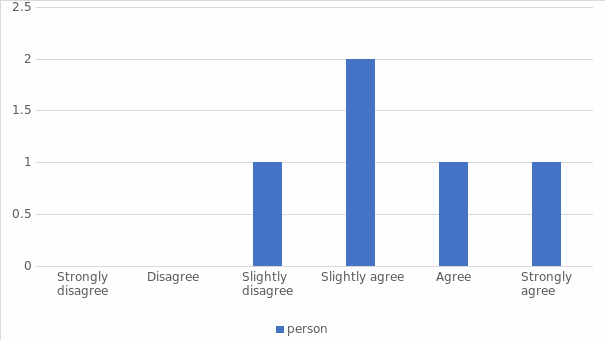
Figures listed above provide information about the main function of a manager is to motivate employees. 80% of people agree with this, only 1 person slightly disagrees. This shows that the majority of the motel’s personnel are looking to their managers for inspiration and motivation.
2. Motivating employees is directly associated with productivity and overall performance.
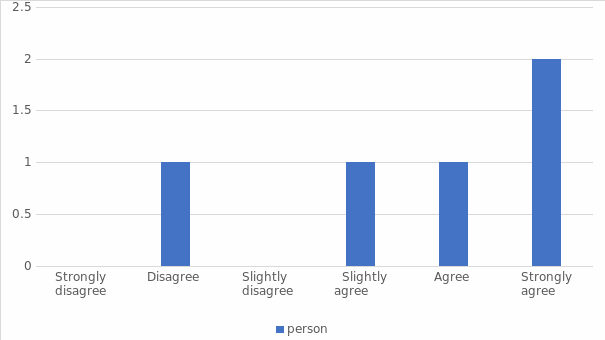
Figures listed above provide information about motivating employees is directly associated with productivity and overall performance. 2 people are strongly agreed, 1 person agrees, another one slightly agrees and one person disagrees. In summary, 80% of participants agree that motivation plays a significant role in their performance.
3. A bonus is an effective strategy to motivate employees.
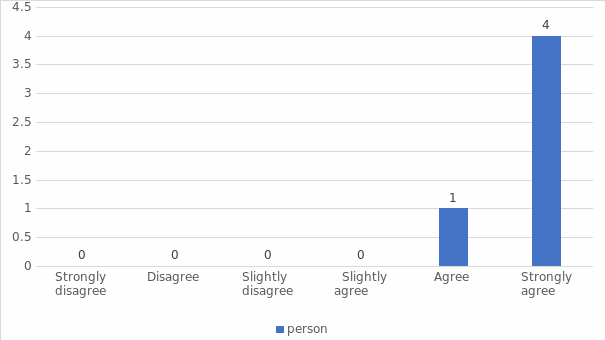
Figures listed above provide the information that bonuses in the effective strategy to motivate employees. All 5 people agree, 4 of them are strongly agreed. This means that all of the employees are interested in monetary rewards and would likely show increased performance to obtain said bonuses.
4. Punishments are another effective motivation strategy.

Figures listed above provide the information about the punishments is another effective motivation strategy. All 5 people are equality have a different opinion, but no one is strongly agreed. Each employee has a different opinion. However, as the data shows, the majority of the responders (60%) would not appreciate responding to negative reinforcement.
5. Friendliness in communication is the foundation of workplace relations and creating the needed atmosphere in the workplace.

Figures listed above provide the information that friendliness in communication is the foundation of workplace relations and creating the needed atmosphere in the workplace. 4 people are strongly agreed and 1 person is slightly agreed. Conclusion: everyone enjoys friendliness and communication in the workplace.
6. I prefer an inspiring leader.
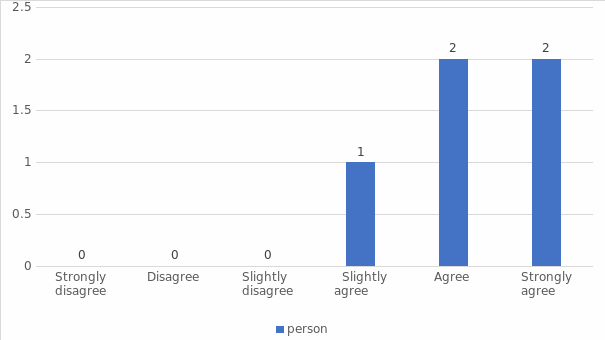
Figures listed above provide the information about inspiring leaders, 2 people are strongly agreed, 2 people are agreed and 1 person is slightly agreed. Conclusion: everyone prefers an inspired leader over an uninspired one.
7. Personal development opportunities motivate employees.
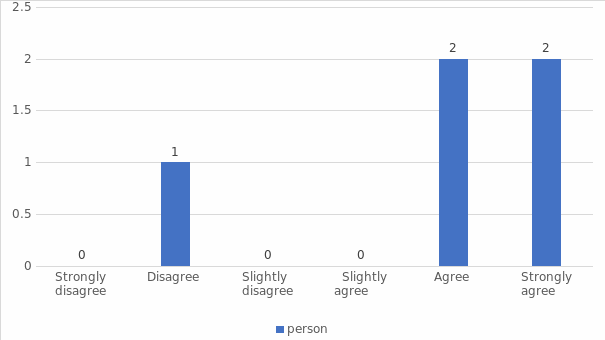
Figures listed above provide the information that personal development opportunities motivate employees. Only 1 person disagrees, and the rest of the people agree.
8. Giving help when you need is motivation.
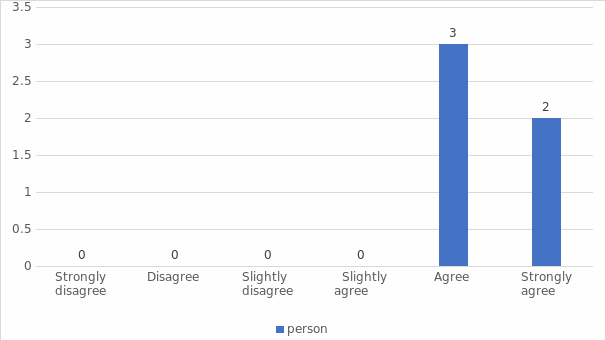
The figures listed above provide the information that giving help when you need is motivation. 3 people agree, the rest of the people strongly agree.
9. Providing compensation to us every time we deserve it.
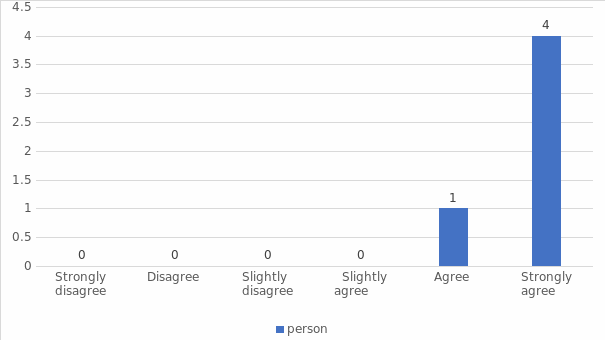
Figures listed above provide the information that providing compensation to us every time we deserve it. 80% of people are strongly agreed, 1 person agrees.
10. Good communicated skill motivates employees.
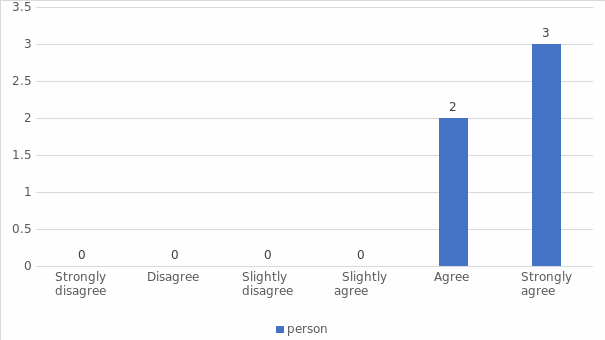
Figures listed above provide the information that good communicated skill motivates employees. 3 people strongly agree, and 2 people agree.
11. Giving enough freedom to employees is motivation.
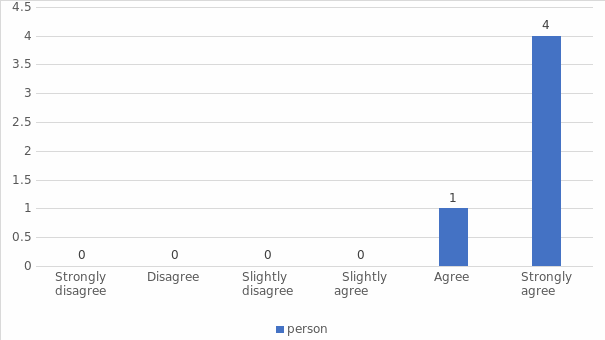
The figures listed above provide the information that giving enough freedom to employees is motivation. 4 people strongly agree, and 1 people agree.
12. Considering the opinion of the employee when making vital decisions.
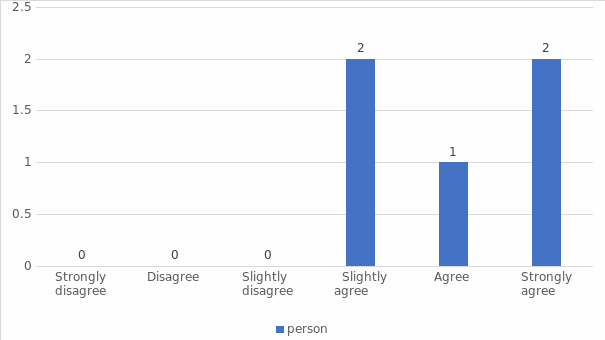
Figures listed above provide the information considering the opinion of the employee when making vital decisions. All 5 people agree, 2 of them strongly agree.
13. Good working relationships with the manager is motivation.
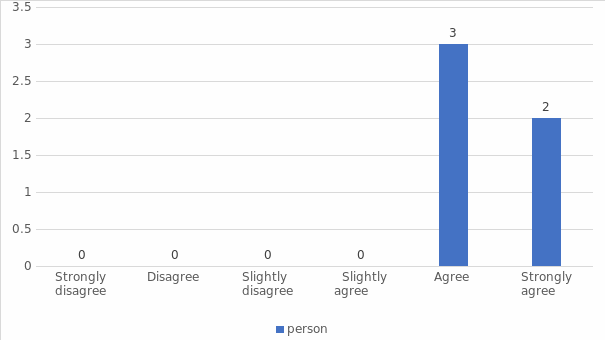
The figures listed above provide the information that good working relationships with the manager are motivation. 3 people agree and 2 of them strongly agree.
14. Providing an employee’s rest time is motivation.

Figures listed above provide the information that providing the employee’s rest time is motivation. All 5 people strongly agree.
- Hoping to obtain the protection of rights and opinions when I work with senior management.
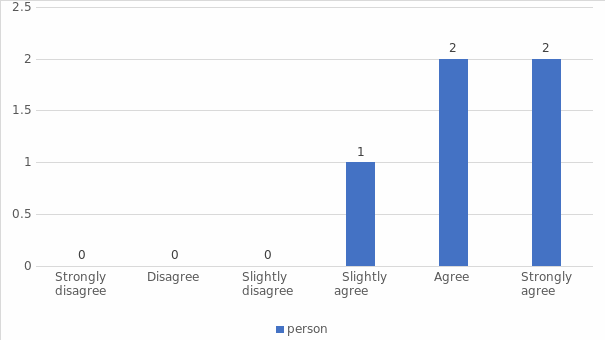
Figures listed above provide the information that hoping to obtain the protection of rights and opinions when I work with senior management. 2 people strongly agree, 2 people agree and the rest people slightly agree.
16. Treat decently and equally both part and full time is motivation.
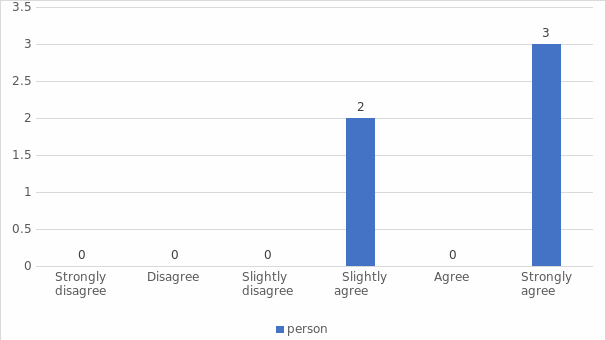
Figures listed above provide the information that treats decently and equally both part and full time is motivation. 3 people strongly agree and 2 of them slightly agree.
17. Unique corporate culture in the workplace should focus on constant
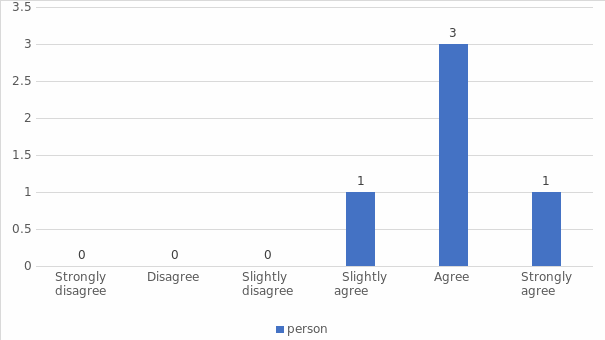
Figures listed above provide the information that unique corporate culture in the workplace should focus on constant. 3 people agree the rest 2 people are slightly agreed and strongly agreed.
18. Suitable inclusiveness and manager’s dedication motivate us.
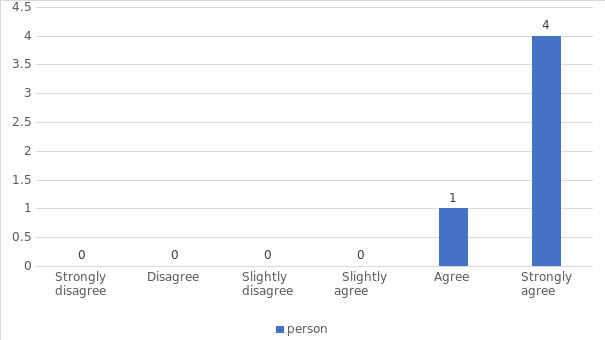
Figures listed above provide the information that suitable inclusiveness and manager’s dedication motivate us. 4 people strongly agree and 1 person agrees.
19. When distributing work-related tasks, employees’ interests and talents are valued.
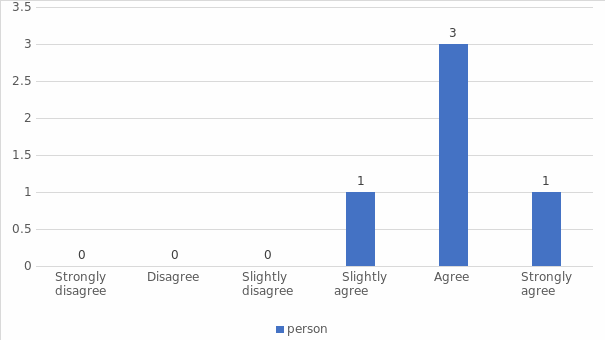
Figures listed above provide the information that when distributing work-related tasks, employees’ interests and talent are valued. 3 people agree, 1 person strongly agree and another one slightly agrees.
20. Manager respect for my professional goals and participate to achieve my goals.
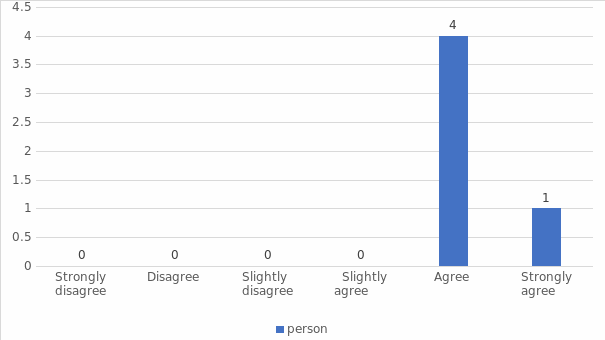
The figures listed above provide the information that managers respect for my professional goals and participate to achieve my goals. 80% of people agree, and 1 person strongly agree.
Recommended solutions and rationale
Based on the initial assessment of the situation regarding the employee motivation at the motel in New Zealand, as well on the quantitative data provided from the surveys, it is possible to identify several crucial problems in this particular enterprise:
- The manager is not interested in promoting motivational policies and does not require his employees to strive to excel.
- The manager’s approach towards his duties is abrasive and does not solicit a healthy and friendly atmosphere among the employees, which hampers intrinsic and extrinsic motivation.
- The motel lacks an established and comprehensive system of rewards for exceeding performance, which in turn gives no reason for the employees to exceed the bare minimum that is expected of them.
- The employees are content with their current level of performance, and would not make a conscious effort to improve their productivity and the quality of their service unless forced to.
Each of these problems requires a solution, as a complex set of measures is to be taken to drastically improve the quality of service in the motel, which could only be done via raising not only the standards of service but also the motivation of the employees for them to meet these expectations willingly. The proposed set of measures to improve employee motivation and performance is as follows:
- Replace the manager.
- Introduce a coherent and comprehensive system of rewards for exceeding expectations and improving performance, as opposed to a system of penalties and deductions.
- Get involved with the employees on a personal level
- Get the employees to associate the struggles of the motel with their own and ensure their involvement in the face of the enterprise.
As it was mentioned in numerous sources dedicated to employee performance and organizational commitment, one of the most important duties of a manager is to increase employee motivation and empower them to perform better. A manager who cannot do that should not be occupying the position. Based on employee feedback, it can be concluded that the current manager cares little for employee motivation. It could have been possible for a said manager to improve his practices and start motivating the employees, but the use of coarse language and general attitude towards people indicates that the relationship between the manager and the employees have already taken a turn for the worst, and rebuilding said relationships would take a lot of time. On the other hand, introducing a new manager would allow for a fresh start and a better manager-employee relationship down the road. Should employees resist improving their performance, being too inclined to act according to the “old ways,” it may be recommended to replace the employees.
A coherent system of bonuses and premiums should be developed and made known for the employees. Bonuses are a great external motivator for many people, and they should know what is expected of them if they wish to receive said bonuses. That way, the employees would know exactly what to improve in their routine, if they wish to receive more credit than they already do. Using punishment and deductions is not recommended, as negative reinforcement tends to poorly affect morale and lead to personal grudges, which are not solicited in the workplace.
Lastly, the new manager is to be instructed in using motivational techniques to promote motivation, dedication, and hard work among the employees. Said manager must be knowledgeable of various leadership techniques, such as the MLS and the concept of the Leader-servant, which suggests that the leader is supposed to be an enabler for the employees to grow both in skill and in personal qualities. The questionnaire indicates that employees would feel motivated if their lifestyles, performance, and personalities are treated with respect and appreciated by the managerial staff. The manager must know what the employees are expecting of them, and act accordingly.
Lastly, every employee working in the motel should be involved in the life and struggles of the motel. While the feelings of personal involvement are hard to solicit in a large company with hundreds or thousands of employees, in a small business such as this one, it is very possible to get employees involved and motivated by making them associate themselves with the motel. Should the compensation system be based on how well the motel is doing, it would be possible to motivate the employees to work harder to improve their salaries. Also, the sense of purpose and belonging could act as a strong intrinsic motivator to improve performance, without any additional material rewards. It is well-documented that if employees work at a particular place for extended periods, they begin to associate themselves with the job and the place of work, meaning that the motel would have certain personal and emotional value to them. It would motivate the employees to improve for the sake of saving the enterprise that they began to associate themselves with, as a form of corporate loyalty.
Conclusion
Motivation is an important factor that affects the performance of the employees and either inhibits or prevents them from growing in skill and improving their personal qualities. Numerous companies across the world are investing time and money into research and facilitation of the best techniques to motivate and inspire their employees’ performance. A motivated employee is more likely to perform better, improve in skills, and solicit personal growth, whereas an unmotivated employee would rarely perform beyond the required bare minimum. As the competition among businesses grows, employee motivation may be a defining factor between the leader and the outsider.
This is particularly true for the hospitality industry, where motivation affects not only the quality of services but also the quality of customer treatment, as the difference between a motivated and an unmotivated employee is visible not only to the manager but to the customer as well. The problem of motivation in the hospitality industry is pressing, as hotels often suffer from high turnover rates due to burnout and poor employee motivation, coupled with poor managerial practices and a lack of effort. The work of a hotel receptionist or an entertainer is often invisible, and thus is rarely appreciated, which leads to a lack of satisfaction and poor motivation. This study highlights the major motivation problems in the industry by showcasing a situation in a small motel business.
In this qualitative research, we analyzed the factors that contribute and diminish the motivation of a particular motel that remains unnamed for the sake of privacy protection. The findings presented in this research are similar to those conducted in other spheres of the hospitality industry, as the demands towards managers and factors that improve employee motivation remain somewhat universal. These factors are:
- Manager participation and cohesion with the employees.
- Coherent and understandable system of rewards.
- Respect and acknowledgment of individual personality and effort.
Based on the described situation as well as the survey findings, it has been concluded that the optimum way for the hotel to increase employee motivation and performance is to change leadership and appoint a new manager, get said manager involved with the lives of other employees and motivate them through personal example and various motivation techniques, and develop a system of rewards that every employee understands and is aware of. These changes, though significant, would enable the motel to expand itself and attract new customers through improvements in customer service and the quality of care.
References
Avbar, D. (2014). Motivation in the workplace and its influence on the effectiveness of work. Revija za Univerzalno Odličnost, 5(3), 222-232.
Biswakarma, S. K., & Sharma, S. (2015). Impact of motivation on employee’s turnover and productivity in hotels (FHRAI listed) of Kolkata. International Journal of Innovative Research & Development, 4(13), 51-60.
Cetin, I. (2013). Motivation and its impact on labor productivity at hotel business “a conceptual study.” International Journal of New Trends in Arts, Sports & Science Education, 2(1), 70-79.
Henderson, A., Schoonbeek, S., & Auditore, A. (2013). Processes to engage and motivate staff. Nursing Management – UK, 20(8), 18-25.
Marshall, T., Mottier, E. M., & Lewis, R. A. (2015). Motivational factors and the hospitality industry: A case study examining the effects of changes in the working environment. Journal of Business Case Studies, 11(3), 123-132.
Putra, E. D., Cho, S., & Liu, J. (2017). Extrinsic and intrinsic motivation on work engagement in the hospitality industry: Test of motivation crowding theory. Tourism & Hospitality Research, 17(2), 1-14.
Ramadanty, S., & Matinus, H. (2016). Organizational communication: Communication and motivation in the workplace. Humaniora, 7(1), 79-88.
Tanaka, A, Okuno, T., & Yamauchi, H. (2013). Longitudinal tests on the influence of achievement goals on effort and intrinsic interest in the workplace. Motivation & Emotion, 37(3), 457-464. Web.